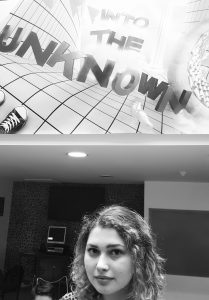
15th of August 2018
Binaural Audio: A Poetic Immersive Landscape
Suspend your disbelief beyond the confines of four black walls, become immersed in a world so all-consuming you forget time and space. Become present in someone else’s head. This is the aim of Living Record Production’s, Thrown by Jodi Gray – “how do you stage what you don’t see but imagine?”
Director, Ross Drury, speaks in metaphors as if they were as legible as street signs. Like many accomplished artists, he benefits from an active associative memory; he can make many connections within and between his senses – often called an expansive imagination. While an endless imagination is one without borders, an expansive imagination is one ever growing.
An expansive memory needs stimulus. The stimulus, challenge, and muse are sound. Drury describes the sound as if it were a biological material. Audio is within the spine, the structural makeup of the show. Using binaural audio and headphones, the sound is in our heads. This primal incantation disrupts the preconceptions of the soundscape. Yet as auditory memory is translated from short term to long term, it moves to the prefrontal cortex – the same place that wills us to live. These sounds intermingle with our intrinsic needs – with our DNA.
Live theatre is an ephemeral experience. A play involving sound and memory challenges our fleeting notions of impermanence. Iconic memory, when you first see something, lasts for just a moment but echoic memory, sensory hearing, lasts slightly longer 3-4 seconds. It occupies a liminal space – a limbo, enough time to notice, make associations and remember. Within this time frame, the brain can capture and repeat sounds, looping them. Eventually, this makes its way to long-term memory. This is called learning.
Living Record Production self-describes as vivid, dangerous and dreamlike. For sighted individuals, vivid dreams are often silent, as the brain is processing trauma and cataloguing an overload of information; in a dream state, it prioritizes certain information – rarely audio. There is danger in sensory material primarily conveyed through audio – it is disorienting. As the microphone head is rotated you will hear the protagonists voice from all around you; Drury concedes, that this is “the centre of psychosis.” It reflects his ethos – theatrical memory is to “believe chaos could happen at any minute.”
Knowing all this, leave the academic and enter the ephemeral – close your eyes and enter the immersive world of binaural audio. Enter a visual landscape encircled by sound. What you’re hearing, is just for you. Just beyond your earphones is a world of noise – the uncurated pandemonium of festival goers. Its contemplative counterpart is enticing, “it’s like a little secret.”
In the last decade, the Fringe has become a place that necessitates a certain audience appeal to be financially viable. The rising costs of venue, housing, and sustenance, encourage commercial work and deter more experimental ventures. Binaural audio is relatively new to the theatrical world. However, it occupies a unique niche; it is accessible and innovative. It offers a seductive directive: create immersive work with audience firmly in their seats, rehearse a show with all theatrical elements present throughout, do more with less financial risk. Given all this, could binaural audio become mainstream? Binaural audio is one part of a larger movement to reclaim and reinvent the Fringe, a utopian haven for artists, a place for experimentation, discussion, and progress.
Drury hopes to benefit from this emerging market. Yet, he cautions, the reason that Thrown By Jodi Gray is successful is not the novelty of tech. Binaural audio is an explicit and integral part of the script. The show emphasizes memory entwined with sound, as the past and present collide behind, in front and all around each of us. It is a tapestry of theatricality – the implicit energy of encroaching chaos – the suspense of hearing from within the eye of the storm. So close your eyes and imagine, “it’s like a little secret.”


















































